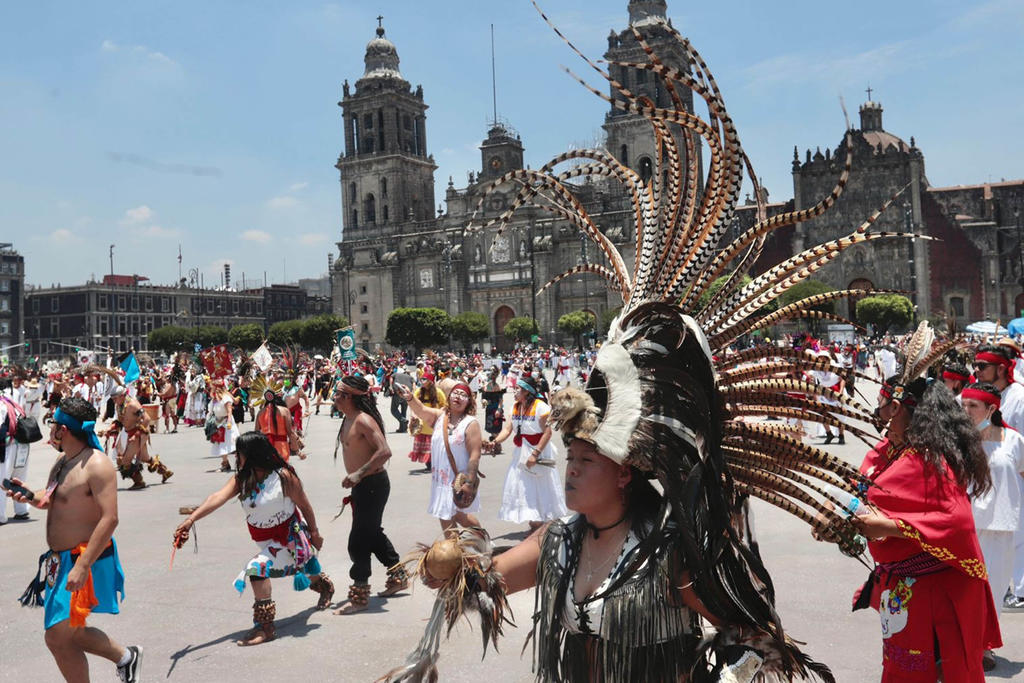Exploring the Diverse Languages Spoken in Mexico: From Spanish to Indigenous Tongues

Mexico stands out for many reasons, including being one of the top 10 countries with the greatest linguistic diversity worldwide. In the Mexican territory, it has been confirmed that there are 11 linguistic families, which encompass 68 languages that derive into 364 variants. Here, we will talk about everything you need to know about the languages spoken in Mexico.
Among the languages spoken in Mexico, Spanish predominates due to the high influence of European Hispanics during the conquest of the territory. However, indigenous languages also prevail, as the natives of this country have always fought to maintain their history and traditions.
It is important to mention that the states of Oaxaca, Chiapas, Hidalgo, Veracruz, Yucatán, Guerrero, San Luis Potosí, Puebla, Quintana Roo, Campeche, and Hidalgo have the highest number of indigenous language speakers, according to data from the National Institute of Indigenous Languages, also known as INALI.
Besides Spanish, the most spoken languages in Mexico are Nahuatl, with 1,725,000 speakers; Maya, with over 859,000 speakers; Tseltal, with 556,000 speakers; Mixtec, with 517,000 speakers; Tsotsil, with 487,000 speakers; Zapotec, with 479,000 speakers; Otomí, with 307,000 speakers; and Totonac, Chol, and Mazatec, each with approximately 200,000 people who speak these languages.
Languages Spoken in Mexico: The Predominance of Spanish
One of the most important languages spoken in Mexico today is Spanish. This is primarily because the majority of the country’s population speaks Spanish. The origin of Spanish in Mexican territory dates back to the voyages of the explorer Christopher Columbus to the American continent. When Columbus arrived in America, he opened a new travel route for the natives of Europe, which in turn allowed the Spanish Empire to dominate the area of Mesoamerica and Aridoamerica.
Therefore, despite having multiple cultures and empires, including the notable Aztec Empire, the Mexican territory is now dominated by the Spanish language. At the beginning of the conquest, the capital of the territory was located in what is now Mexico City.
It is important to mention that at the start of the explorations, the Spaniards and Mexicans had a good relationship. However, this relationship ended in war. After a difficult struggle, the Spaniards triumphed and thus began what is formally known as the domination by the Spanish crown in Mesoamerica and Aridoamerica. This is how the Spanish language gradually became predominant in the country, leading to what it is today.
During this period, in addition to solidifying the use of Spanish, a combination of Spanish with indigenous languages emerged, resulting in a cultural fusion between people with Spanish roots and those with Mesoamerican roots. Moreover, there is a significant influence of English today.
Learn all about: Mexican Flag vs Italian Flag: Key Differences and Historical Background
Characteristics of Mexican Spanish
When discussing the languages spoken in Mexico, Spanish predominates above all. One of the most notable characteristics of Mexican Spanish is the value of the letter “x,” which in Mexico can be pronounced as “ks,” “s,” “j,” or even “sh.” Additionally, there is the pronunciation of double consonants such as “tz” and “tl,” which do not exist in classical Spanish.
Indigenous Languages in Mexico
When discussing the languages spoken in Mexico, it is essential to mention the indigenous languages, which are also of great importance in the country. It might be surprising to learn that Spanish is not the only official language, as several native languages are also recognized as official in Mexico.
The General Law of Linguistic Rights of Indigenous Peoples in Mexico recognizes 68 indigenous languages as national languages. Additionally, research indicates that approximately 7% of the Mexican population speaks an indigenous language.
The indigenous languages with the largest number of speakers include Nahuatl, Maya, Mixtec, Zapotec, and Otomi. On the other hand, some indigenous languages are endangered, such as Awakateko in Campeche, Ku’ahl and Kiliwa in Baja California, Mocho’ in Chiapas, Tejalápam in Oaxaca, Ixcateco and Zapotec in San Felipe, Ayapaneco in Tabasco, Zapotec in Mixtepec, as well as Nebajeño and Kaqchikel in Quintana Roo.

It is also worth noting that there are 68 indigenous linguistic groups. Here they are listed:
- Akateko
- Amuzgo
- Awakateko
- Ayapaneco
- Cora
- Cucapá
- Cuicateco
- Chatino
- Chichimeco Jonaz
- Chinanteco
- Chocholteco
- Chontal of Oaxaca
- Chontal of Tabasco
- Chuj
- Ch’ol
- Guarijío
- Huasteco
- Huave
- Huichol
- Ixcateco
- Ixil
- Jakalteko
- Kaqchikel
- Kickapoo
- Kiliwa
- Kumiai
- Ku’ahl
- K’iche’
- Lacandón
- Mam
- Matlatzinca
- Maya
- Mayo
- Mazahua
- Mazateco
- Mixe
- Mixteco
- Náhuatl
- Oluteco
- Otomí
- Paipai
- Pame
- Pápago
- Pima
- Popoloca
- Popoluca of the Sierra
- Qato’k
- Q’anjob’al
- Q’eqchí’
- Sayulteco
- Seri
- Tarahumara
- Tarasco
- Teko
- Tepehua
- Northern Tepehuano
- Southern Tepehuano
- Texistepequeño
- Tlahuica
- Tlapaneco
- Tojolabal
- Totonaco
- Triqui
- Tseltal
- Tsotsil
- Yaqui
- Zapoteco
- Zoque
The Cultural Importance of Indigenous Languages
Indigenous languages spoken in Mexico hold great importance for the country’s culture, as they provide unique insights into its history and traditions. Through these languages, one can discover and understand everything related to Mexico’s past.
Moreover, indigenous languages are a means of promoting peace and sustainable development in the country. They contribute to the protection of human rights and the freedom of the native Mexican population.
Main Indigenous Languages
As mentioned earlier, Mexico is one of the countries with the greatest linguistic diversity. Here are some of the principal indigenous languages:
Náhuatl
The Náhuatl language can be traced back to the beginnings of Teotihuacán, around the 4th century AD. The language has developed numerous dialectal varieties over many periods and processes. It was used by various peoples and civilizations throughout its history in Mesoamerica.
Náhuatl is a Uto-Aztecan language, part of the Amerindian language family. It is one of the official languages of Mexico and is also spoken in countries like Nicaragua, the United States, El Salvador, and Guatemala.
Some everyday Spanish words of Náhuatl origin include petate, Chalco, Tula, aguacate, Ecatepec, Querétaro, chocolate, Tlatelolco, Xalapa, Guanajuato, Mixcoac, Aztlán, Chapultepec, and Xochimilco.
Yucatec Maya
The Yucatec Maya language, like all Mayan languages, descends from a proto-Mayan language with records dating back 5,000 years. It originated in Mesoamerica and expanded through a set of Mayan languages, a family of languages with several similar characteristics.
This language is synthetic and economical, with a monosyllabic morphological base. Yucatec Maya is spoken in several areas of Mexico located in the Yucatán Peninsula, Campeche, and Quintana Roo, as well as in Belize.
Learn all about: Famous Mexican Women: Pioneers Who Forged History
Government and Language Policy
In Mexico, there is a wide variety of indigenous languages, prompting political authorities to establish a law aimed at protecting these languages. This law seeks to protect the right of all Mexicans to communicate in their native language without any restrictions.
This initiative aims to constitutionally recognize the right of indigenous peoples to preserve their traditions and languages. The law was consolidated in 2003 after the enactment of the General Law of Linguistic Rights of Indigenous Peoples, which had its latest reform on April 28, 2002.
The objective of this law is to regulate the recognition and protection of the linguistic rights of indigenous peoples and communities, thereby promoting the development of the languages of native Mexicans.
It is important to highlight that fostering the protection and development of indigenous languages is directly related to contributing to thoughts and ideas that are free from racism. Additionally, it is a way to improve communication and creativity among humanity.

Marginalization of Indigenous Languages and the Risk of Extinction in Mexico
When discussing the languages spoken in Mexico, it is necessary to emphasize the challenges faced by indigenous languages. According to UNESCO, both in Mexico and other parts of the world, at least 43% of the approximately six thousand languages spoken worldwide are in danger of extinction.
This is precisely why the Mexican government seeks to promote activities in indigenous territories that help keep the country’s native languages alive. Furthermore, centers for indigenous language studies have been created in universities, documentation in indigenous languages has been produced, publications in these languages have been edited, and the teaching of Mexican indigenous languages has been introduced in schools.
Other Languages in Mexico
In addition to the numerous indigenous languages and Spanish, other languages also stand out in Mexico, with English being the most prominent. The country has strong ties to the English language due to its proximity to countries like the United States and Belize. Furthermore, the tourism connection with Canada and academic links with the United Kingdom further strengthen the linguistic relationship with the official language of these countries.
It is important to mention that English is the fourth most spoken language in Mexico. Currently, it is estimated that more than 50 million Mexicans speak English at a basic level. Additionally, in tourist destinations like Cancún, Puerto Vallarta, Tulum, and Mexico City, English is the second most dominant language.
Apart from English, there are other languages that are not considered national, such as Venetian, Plattdeutsch (a German-origin language spoken in the states of Zacatecas, Campeche, Durango, and Chihuahua by a small community), Chipileño (of Italian origin spoken in the city of Chipilo in Puebla), as well as Chinese, Japanese, Arabic, among others.
Here’s what you should know about: Mexican Telenovelas: A Deep Dive into Their Popularity and Impact







